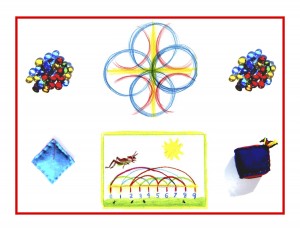Day 33
For one year, 365 days, this blog will address the Common Core Standards from the perspective of creating an alternate, ambient learning environment for math. Ambient is defined as “existing or present on all sides, an all-encompassing atmosphere.” And ambient music is defined as: “Quiet and relaxing with melodies that repeat many times.”
Why ambient? A math teaching style that’s whole and all encompassing, with themes that repeat many times through the years, is most likely to be effective and successful. Today’s blog will focus on the Snack and Story Time segments of the Kindergarten day, along with suggestions for integrating the Common Core Standards and their ambient math counterparts that appeared in this blog on Days 13, 14, and 15. The approach here will be more general since the posts from Days 13 and 14 echo each other, and the Day 15 post simply suggests combining its math activity with elements from the fairy tales told in the Story segment.
First a word about the nature of the Snack and Story Times and how the two are sometimes combined. Repetition, as the necessary scaffolding for young children, is practiced most of the day in the Waldorf Kindergarten. Many Waldorf Kindergartens have the same foods (often different grains) on the same days of the week. So Monday might be oats, Tuesday, millet, and so on. This anchoring in a familiar, comforting routine is essential to the littlest ones as they bravely navigate through a wonderful, strange, and sometimes frightening world.
Ancient fairy tales, like the Grimm brothers collection, provide an essential mooring for the uncharted and uncertain seas of early childhood. The story is told (ideally told rather than read) by the teacher/parent, and is repeated every day for one to two weeks. The stories go so deep that they are very often acted out in the child(ren)’s play. You might say that they are “trying on” ways to be in the world. This is learning at its most essential, and should definitely not be interrupted by abstract teaching, drills, and tests.
Here is an excerpt from the introduction to the Math By Hand first grade fairy tale book (each number from 1-12 is introduced through its own fairy tale). “In the story ‘The Queen Bee,’ when it was the youngest prince’s turn to seek in the moss for the princesses’ 1,000 pearls, ‘It was so very difficult for him to find the pearls, and he got on so slowly, that he seated himself on a stone, and wept.’ Finding the 1,000 pearls in the moss is parallel to finding the 1,000+ pearls of wisdom embedded in these ancient tales. The 5,000 ants who come to the prince’s aid were sent by the King of Ants whose life he had saved, who had promised to help the young prince if he should ever need it. ‘ . . . and before long, the little creatures had got all the pearls together and laid them in a heap.’
At this particular time in history, as we become increasingly caught up in technology and focused on all things scientific, sacrificing fantasy and the imagination in favor of the rational, there’s an urgent need for the modern mindset to make room for childhood, now at risk, since its very essence is imaginative fantasy. The child’s nature is such that connections to the unconscious are more tangibly apparent than in the adult. It is these closer connections that, combined with childish innocence and vulnerability, create a need for reassurance that all will be well, in the end. Fairy tales fit all of these needs, beautifully and effectively.”
Story and snack can be successfully combined, using stories that fit the particular cooking, baking or other food preparation activity taking place on any particular day. The blog posts for Day 13 suggests using the stone used to cook the stone soup as a likely candidate for this part of the standard: Describe several measurable attributes of a single object. (Find a version of the story in the Day 21 post.) And cooking the stone soup itself nicely fills this part of Day 14’s standard: Compare two objects with a measurable attribute in common, to see which object has more or less of the attribute, describing the difference. Many such opportunities abound while preparing and cooking food!
The Day 15 post’s standard: Classify objects into given categories, and sort the categories by count. fits the fairy tale mentioned above, “The Queen Bee.” It has the elements mentioned at the end of Day 15’s post, and may be an excellent one to adapt to classifying and sorting. Many fairy tales do have this feature in common. Stories, with their vibrant, memorable images, can be the beating, lively heart of all your teaching, from Kindergarten through the upper grades. The Waldorf story curriculum is a study in bringing the child gently into the world, as it morphs from fairy tales, to fables, to myths, to modern history (the latter enlivened with the anecdotal and biographical).
So we come to the end of Kindergarten! At the end of every grade I will attempt an ambient math interpretation of the Standards for Mathematical Practice. There are eight of them and they are quite complex and dense. So, we will see how many days will be needed for this. Please remember that knowledge ensues in an environment dedicated to imaginative, creative knowing, where student and teacher alike surrender to the ensuing of that knowledge as a worthy goal.












